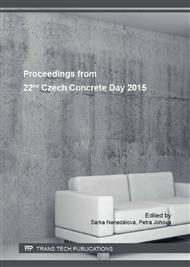p.102
p.108
p.112
p.119
p.125
p.131
p.136
p.142
p.147
New Model for Concrete Creep and Shrinkage Prediction and its Application
Abstract:
At the beginning of this year prof. Z. P. Bažant and his team published a new numerical model for predicting creep and shrinkage in concrete structures. Model, named B4, is conceptually based on the previous version B3. While early prediction models were based mostly on classical concrete composition, the new model allows for observation the variability of modern concrete compositions, i.e. the effects of admixtures, various aggregate types and increasing concrete strength. The model also captures the effects of environment temperature, multi-decade prediction and autogenous shrinkage. This is important for concretes that are produced in Czech Republic and have higher, but not high strength (about 50 MPa). The model also allows to determine internal parameters according to experimental measurements on laboratory specimens or structural members. Therefore it is possible to refine the prediction of the behavior of structures made of this concrete in the long time periods. However, the increased number of input parameters leads to a higher complexity and it is necessary to have computational tools for practical model application. To provide the model to wider engineering community open structure computational program (in MATLAB environment) was created. Software is freely available for download on the internet. Description of the innovations of the model B4 and demonstration of its relatively simple applications using newly developed software products is a subject of this paper.
Info:
Periodical:
Pages:
125-130
Citation:
Online since:
April 2016
Authors:
Keywords:
Price:
Сopyright:
© 2016 Trans Tech Publications Ltd. All Rights Reserved
Share:
Citation:


